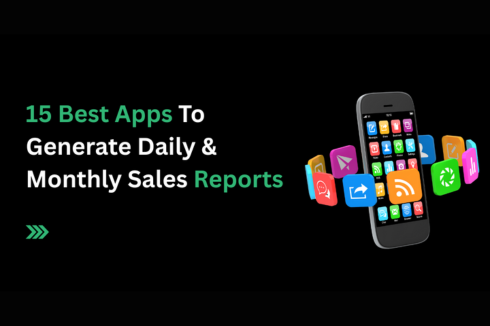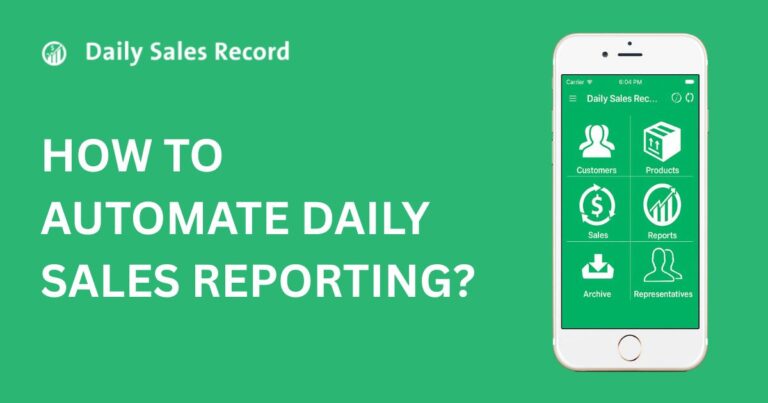15 Advanced Sales Tracking Strategies For Growing Businesses
72% of small businesses lose revenue due to poor sales tracking. Missed follow-ups, untracked leads, and delayed responses quietly kill growth. That’s where Sales Tracking Strategies becomes your competitive edge. It reveals what’s converting, where deals stall, and how each rep performs daily. With the right strategy, you fix leaks before they drain your pipeline.
Quick wins like tracking daily sales activities, scoring leads, and reviewing pipeline movement weekly drive results fast.
At Daily Sales Record, our app makes all this easy, track deals, reps, inventory, and invoices from one mobile dashboard. Let’s explore the sales tracking strategies your business needs to grow.
What Is Sales Tracking?
Sales tracking means recording and analyzing every activity tied to your sales process. You track data like calls made, emails sent, meetings booked, deals created, and deals closed. Each action gets recorded using CRM systems, spreadsheets, or tracking software.
You monitor how leads move through the funnel from contact to close. This involves logging timestamps, updating deal stages, and tagging deal sources. You also track sales rep activities, pipeline progress, and lead interactions.
These details get collected daily, so nothing slips through. You can then segment the data by source, channel, rep, or product line. The goal is to keep a real-time view of your entire sales operation. Sales tracking shows you what’s happening at each step without relying on assumptions or scattered information.
Importance of Sales Tracking for Business Growth
Sales tracking isn’t just data collection. It’s the backbone of consistent growth. Without it, you’re flying blind. Here’s why it matters:
Real-Time Visibility
You track every activity and deal stage in real time using CRM dashboards. No more guesswork or outdated reports. This lets you detect pipeline issues early before they impact targets. For example, if demos drop week over week, you’ll catch it instantly and reassign tasks as needed.
Performance Accountability
You track sales activity per rep calls, follow-ups, and conversions. This identifies who’s moving deals and who’s stalling. You can set benchmarks for daily actions and hold reps accountable with scorecards. Precise tracking improves consistency and effort across your entire team.
Accurate Forecasting
Tracking close rates, deal age, and pipeline stages gives you reliable projections. You don’t rely on rep optimism or guesswork. For example, if your team converts 22% of SQLs on average, you can forecast monthly revenue based on volume. This supports more thoughtful planning and growth targets.
Better Resource Allocation
Sales tracking shows which campaigns, lead sources, or reps drive results. You see if Google Ads converts better than LinkedIn or if one product line performs stronger. Based on actual data, you can shift your time, team, and budget toward high-performing assets.
Faster Sales Cycles
By logging deal stage durations, you see where leads slow down. If proposals take 10 days but demos only two, that’s a fixable gap. You optimize handoffs and tighten workflows. This reduces average cycle time and shortens the path to revenue.
15 Powerful Sales Growth Strategies for 2025
1. Set SMART Sales Goals
You need specific sales targets to track progress effectively. Vague goals create confusion and weaken performance. Use the SMART framework like Specific, Measurable, Achievable, Relevant, and Time-bound. Break annual targets into monthly and weekly quotas. Assign KPIs like conversion rate, deal size, or call volume.
For example, aim to close 20 qualified leads monthly from inbound SEO traffic. Tie each goal directly to your pipeline stages and sales reps’ daily activity. That’s how you track with precision.
2. Track Sales Activities Daily
Track all front-line actions like outbound calls, emails, follow-ups, discovery meetings, and proposal sends, all inside your CRM. These are your leading indicators, not lagging results. Set daily activity benchmarks per rep based on historical win rates and pipeline stage conversion data. Use activity reports to spot performance gaps early.
Integrate call-tracking software and email analytics to log engagement metrics automatically. For example, track the response rate per 50 emails sent. This data shapes accurate forecasts and coaching insights.
3. Use a Centralized CRM System
You need a single platform to capture, organize, and analyze all sales data. That’s your CRM or Customer Relationship Management system. It tracks every lead interaction, logs activities, updates deal stages, and connects with your email, calendar, and calling tools.
Choose a CRM that offers real-time pipeline views, role-based dashboards, and workflow automation. CRMs like HubSpot or Pipedrive also support lead scoring, sales velocity tracking, and quota progress. Without centralized data, your tracking loses accuracy and structure.
4. Define Your Sales Pipeline Clearly
Build a pipeline that mirrors your sales process, from lead capture to closed-won or lost. Define each stage with clear entry and exit criteria, like “Qualified Lead = completed discovery call.” Use CRM deal stages to map this flow and assign probabilities to each phase for accurate forecasting. Track stage conversion rates, deal age, and drop-off points.
This structure lets you monitor deal movement and identify where reps stall. Without this clarity, tracking becomes guesswork.
5. Automate Lead Logging and Deal Updates
Manual data entry wastes time and introduces errors. Use CRM integrations to automatically log emails, calls, web form submissions, and chat interactions. Set rules to auto-assign leads based on territory, source, or product interest.
Trigger deal stage updates when specific actions like “proposal sent,” move the deal to “Negotiation.” Tools like HubSpot, Zoho, or Salesforce automate these workflows. With automation, you track clean, real-time data that accurately reflects rep activity and deal progress.
6. Customize Your Dashboard by Role
Every team member needs data relevant to their function. Sales reps should see lead status, activity logs, and deal velocity. Managers need views of team performance, pipeline stages, and forecast accuracy. Use role-based dashboards in your CRM to surface the right KPIs.
Customize filters, widgets, and data modules for each user type. For example, a closer may track win rate and average deal size, while SDRs focus on daily outreach. This keeps tracking aligned with accountability.
7. Implement Lead Scoring Systems
You need lead scoring to track sales readiness and deal prioritization. Assign scores based on demographics, firmographics, and behavior. Track actions like email clicks, product page views, and demo requests.
For example, a SaaS lead who signs up for a free trial opens your emails, and matches your ICP might score 90. That lead moves to “Sales Qualified.” This tracking method lets you focus on high-intent leads and improves real-time funnel visibility.
8. Monitor Sales Cycle Length
Track how long it takes to move a lead from initial contact to a closed deal. Use CRM timestamps to measure average deal duration across pipeline stages. Break down cycle length by product type, lead source, deal size, or rep performance.
For example, inbound leads may close in 14 days, while outbound leads take 35. Identify stages with the longest delays. This helps you diagnose bottlenecks and refine sales tactics for faster, more predictable closes.
9. Create a Sales Activity Scorecard
Use scorecards to track daily activities tied to pipeline movement. Assign weighted values to calls, emails, demos, and follow-ups. For instance, a discovery call might score 5 points, while a proposal sent scores 10.
Track each rep’s weekly score against their targets using CRM dashboards. This helps you spot underperformance early and maintain pipeline consistency. Scorecards translate raw activity data into measurable accountability and allow you to track effort versus results across your sales team.
10. Segment Tracking by Source and Campaign
Break down leads and conversions by source, campaign, or channel in your CRM. Track performance across Google Ads, organic search, LinkedIn, and email campaigns. Monitor deal count, average value, and close rates by segment.
For example, if Facebook leads close at 7% but email at 18%, reallocate resources. This segmentation improves campaign attribution and shows which sources contribute most to revenue growth across tracked metrics.
11. Schedule Weekly Pipeline Review Meetings
Hold structured meetings to review deal progress, stalled opportunities, and sales velocity. Use pipeline reports to track open deals, stage durations, and close probability. Ask reps to explain movement or lack thereof.
Flag deals older than the average cycle length. For example, if your average close time is 21 days, review all open deals aged 30+ days. Weekly reviews create accountability, sharpen forecasting, and keep your pipeline current and trackable.
12. Track Lead Drop-Off Reasons
Log drop-off reasons in your CRM at every lost deal stage. Use custom fields like “No budget,” “Went with competitor,” or “Timing issue.” Analyze trends by deal size, rep, or industry. For example, if 30% of losses cite pricing objections, review your value proposition.
Tracking these reasons highlights weak points in your funnel and provides actionable data to adjust messaging or qualify leads more effectively.
13. Use Sales Funnel Conversion Metrics
Measure conversion rates between each funnel stage from lead to qualified, to proposal, to closed-won. Set benchmarks by campaign type, rep, and product. For example, track how many MQLs convert to SQLs or how many proposals convert to deals.
Use CRM dashboards to spot drop-off stages. Funnel metrics clearly map where leads stall and how efficiently your team advances deals through each tracked phase.
14. Track Sales Rep Response Time
Monitor how quickly your reps respond to new leads using CRM activity timestamps. Measure each rep’s average first response time. Leads contacted within the first hour are significantly more likely to convert.
For example, compare conversion rates if Rep A responds in 20 minutes and Rep B in 6 hours. Add response time reports to rep dashboards. Tracking this metric improves speed-to-lead and lead engagement quality.
In Closing
Sales tracking isn’t just another routine. It’s a system that drives clarity, speed, and better decisions across your sales process. When you track consistently, you spot real patterns, improve sales team accountability, and react faster to what your data reveals. The right strategy and tool give you complete visibility into every opportunity.
That’s precisely what the Daily Sales Record delivers. It’s simple, innovative, and built for businesses like yours. Ready to streamline your tracking, close more deals, and grow faster? Download the Daily Sales Record app and start taking control today.
Frequently Asked Questions
Questions: How does tracking abandoned deals contribute to future sales success?
Answer. By analyzing why deals fall through, you uncover objections, timing, or pricing patterns. This insight lets you refine pitches and re-engage leads more strategically later.
Questions: What role does territory tracking play in sales performance?
Answer. Territory tracking shows which locations or zones drive better conversions. You can reassign reps, adjust focus, or launch targeted campaigns with higher traction.
Questions: How do I use historical sales data to shape future strategies?
Answer. Reviewing past trends helps you forecast busy seasons, understand buyer behavior, and plan campaigns around proven high-conversion periods.
Questions: Can sales tracking integrate with accounting or ERP systems?
Answer. Yes. Many tools, including advanced CRMs, connect with accounting platforms to sync revenue, expenses, and inventory for a full business view.
Questions: How does tracking individual product performance impact sales growth?
Answer. Monitoring which products sell best across customer segments helps you adjust pricing, upsell more effectively, and stock based on demand trends.


